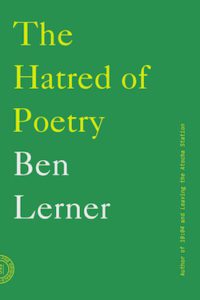
If you’ve ever taught a literature class, you’ve seen it before: the student seated in the back raises his hand, puffs out his chest and proclaims his distaste for poetry, as if pushing broccoli off his plate. As the teacher, you wear an expression of shock, for the sake of performance. And each semester, you ask yourself: What’s at the root of this disdain? And more to the point, what does poetry do to deserve it?
It’s curious that something as seemingly harmless as poetry could inspire hatred, and yet denunciations of the genre are nothing new. Starting with Plato’s argument that poets should be banished, many criticisms have been lobbed over the centuries, some more biting than others. (My favorite diss comes from the early-19th-century English novelist Thomas Love Peacock, who took aim at the poet’s mind: “The march of his intellect is like that of a crab, backwards.”) Today, the battle over the value of poetry rages on.
Enter Ben Lerner. A poet first and foremost, with two celebrated novels under his belt, Lerner attempts to stay above the fray by analyzing the unending debate with fresh eyes. The thesis of The Hatred of Poetry is as clear as it is counter-intuitive: people hate poetry because they hold it in such high esteem—and poems fail to fulfill their lofty promise. It’s not so much a matter of quality, but rather the mechanism by which poetry is produced: “You’re moved to write a poem, you feel called upon to sing, because of [a] transcendent impulse. But as soon as you move from that impulse to the actual poem, the song of the infinite is compromised by the finitude of its terms.” The poem, Lerner proposes, is poetry’s undoing; it cannot live up to its sublime origins. Thus, critics and poets alike are unhappy with what materializes on the page, all the while affirming their faith in what poetry should be. “Hating on actual poems,” he explains, “is often an ironic if sometimes unwitting way of expressing the persistence of the utopian ideal of Poetry.”
But why single out poetry? What separates it from other art forms? “Some kids take piano lessons, some kids study tap dance, but we don’t say every kid is a pianist or dancer.” Lerner recognizes that being called a poet is about more than artistic practice; it’s a marker of human imagination. Figures like Ella Fitzgerald and Philippe Petit are poets because they deliver a message that inspires us—whether they ever composed a sonnet is beside the point. And so society celebrates the role of the poet while spurning poems themselves. (I feel compelled to mention that in the press kit that accompanied my copy of The Hatred of Poetry were many pages of praise for Lerner’s two novels, but none for his three books of poems. Indeed, poetry is “an art hated from without and within”—or at least easily eclipsed.)
A refrain common to recent rebukes of poetry is that today’s poems don’t achieve universality. But is that an appropriate standard? With razor-sharp intelligence sans merci, Lerner dissects Mark Edmundson’s 2013 Harper’s essay criticizing poems that, in Edmundson’s words, “don’t slake a reader’s thirst for meanings that pass beyond the experience of the individual poet and light up the world we hold in common.” If common experience is the goal, then Lerner suggests looking to Whitman, the famed bard of the generalized self. As Lerner wisely points out, however, any blind attempt at universality must backfire: no one poet speaks for everyone. He contrasts how it feels to encounter Whitman’s poetry with the work of contemporary poet Claudia Rankine, whose best-selling book, Citizen, addresses racial injustice and identity: “Whoever you are, while reading Citizen, you are forced to situate yourself relative to the pronouns as opposed to assuming you fit within them.” If Whitman strives to elide differences of personhood, Rankine tacks in the opposite direction, heightening the reader’s awareness of one’s place in a racially determined world. Lerner praises her writing—a blend of poetry, memoir, and visual art—for how it admits inherent imperfections of the lyric, noting that “great poets confront the limits of actual poems.”

For his part, Lerner acknowledges the shortcomings of The Hatred of Poetry, a slim volume. “It doesn’t have much to say about good poems in all their variety,” he writes, adding that another essay might consider “how hip-hop, or spoken word, or other creative linguistic practices” enter into the discussion. He also offers little on poetic praxis outside Western lit. But perhaps a more head-scratching omission is that Lerner, so keen on advancing his own argument, never stops to examine the more usual explanations given for poetry’s unpopularity. According to his calculus, most everyone—from Marianne Moore to the passenger seated next to you in coach—dislikes poetry for being, as Shelley phrased it, a “feeble shadow” of its “original conception.” But what about people who resent poetry because of its association with conceptual high-mindedness—elevated in speech, inaccessible in meaning? What about the student who hates poems for being too hard to understand?
The poetry world has long fretted over the issue of difficulty. Since readership is low relative to other genres, it’s often assumed that many are tuning out on account of frustration. (To remedy this, some have advocated for more accessible poetry, while others, like Charles Bernstein, have railed against any perceived effort to ‘water down’ the art.) The conventional logic is that many contemporary poems are too conceptual for the public, just as abstract art is dinged for being too obtuse. This is where Lerner, if he engaged with complaints about poetry’s difficulty, could flip the script. If he’s right that the best poems are virtual—vague notions that flicker through our heads—then they must remain inaccessible by definition. In a sense, the expression of a poem is never conceptual enough.
This claim that the ideal poem is the one never written is reiterated, as Lerner observes, by countless poets throughout history. But it ignores a key aspect of the art form: named after the Greek word for “making,” poetry—from poiesis—is also rooted in the tactile. In an interview for Bomb, the poet Dean Young describes his methodology: “I make a poem out of what interests me: subjects, phrases, rhymes, blurts, philosophies, recipes, dreams, animals, everything I’ve stolen from other poems. To some extent my process is most often a combination of automatic writing and collage… I want a poem to be a whole thing.” Young’s aspiration isn’t virtual; he constructs poetry as a handiwork of collage, of moving materials around on the page to create something. Or, as Amiri Baraka declared, “Art-ing is what makes art.” This isn’t to dispute the importance of abstract thinking or divine inspiration in the poetic process, but to honor how our bodies give form to poems; how we put them within reach.
Perhaps The Hatred of Poetry is most compelling when reflecting on how poetry shapes our childhoods. Adults are eager, Lerner asserts, to return to that time of nursery rhymes, when language was rich in possibility, when meaning was still something to be discovered. If some of us are salty, at least the sentiment is understandable: “Our resentment of that falling away from poetry takes the form… of contempt for grownup poets and for poems.” Here Lerner is psychoanalyzing the antagonists. It’s no mistake that his book’s closing word is love; he is suggesting that, despite the “rhythm of denunciation and defense,” both sides betray an abiding affinity for what poetry was. Hold dear the haters, for they too come from a place of longing.




